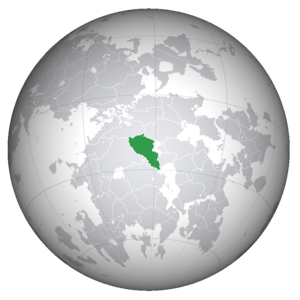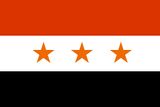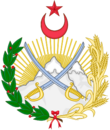Kurzhistan
Kurzhi People's Republic of Kurzhistan | |
|---|---|
| Motto: Allah,Kurzhistan,Duhani | |
 Location of Kurzhistan in Central Thrismari | |
| Capital | Buznar |
| Largest city | Gultan |
| Official languages | Kurzhi |
| Recognised national languages | Kurzhi
Yaddak Abjekh |
| Ethnic groups | Kurzhi 92.45% Yaddak 2.55% Encessi 2.05% Others 2.95% |
| Demonym(s) | Kurzh(s) |
| Government | Unitary one-party Kurzhi socialist republic |
| Fultaz Bin Duhani | |
| Gisnar Al-Fuhad | |
| Legislature | Kurzhi National Assembly |
| Establishment | |
• Foundation of the Republic of Kurzhistan | 1912 |
• October Coup and the Declaration of the Kurzhi People's Republic | 1946 |
| Area | |
• Total | 1,061,070 km2 (409,680 sq mi) |
| Population | |
• 2023 estimate | 38,000,000 |
• 2022 census | 35,556,762 |
| GDP (PPP) | 2021 estimate |
• Total | $266,250,000,000 |
• Per capita | $7,502 |
| GDP (nominal) | 2021 estimate |
• Total | $195,250,000,000 |
• Per capita | $5,506 |
| Gini (2021) | low |
| HDI (2021) | high |
| Currency | Sherih (W) |
| Time zone | UTC-2 |
• Summer (DST) | UTC-2 (not observed) |
| Date format | dd-mm-yyyy |
| Driving side | left |
| Calling code | +91 |
| ISO 3166 code | KHK |
| Internet TLD | .sta |
Kurzhistan, formally known as the Kurzhi People's Republic of Kurzhistan, is a Country located in the region of Central Thrismari inside the continent of Thrismari on Anteria. It is geographically located in the Central Thrismarian highlands, and borders Bashkaristan to its north, Abjekistan to its West and Encessia to its south. Kurzhistan has a population of 35.5 million people as of 2022.
Buznar is the capital and Gulnar is the largest city of the country. Kurzhistan comprises of Twenty six provinces and five districts of importance.
Etymology
Kurzhistan is the common name utilised for the Kurzhi People's Republic of Kurzhistan and has been regarded as the only name that the nation is known as, however that couldnt be further from the truth, Kurzhistan's original termology stems from the yaddak era, when the area was known as Qurzi-sthan or land of the Qurz which was the yaddak abbreviation for the Kurzh People.
As time went on however, the Yaddak's gradually latinised the name, and Qurz became Kurzh while Qurz-sthan came to be known as Kurzhi-stan or Land of the Kurzh, this termiology continued and the region came to be called by its latinized version, i.e Kurzhistan, instead of the generic Qurzsthan, which happened mostly due to the passage of time and the changing linguistics of the abjekh people with names being made easier to memorise and to pronounce, so that administrative works could be easily done.
However, even after kurzhi's won their independence from the yaddaks in the 1910's, this termiology of the yaddaks continued, and the Qurzi's identified themselves as Kurzhi's and their nation as Kurzhi-stan rather than Qurzi-sthan mostly due to the cultural influence of the abjekhs on the kurzhi's as a result of a prolonged administration of kurzhi areas, by the abjekhi royal government that went on for several centuries.

